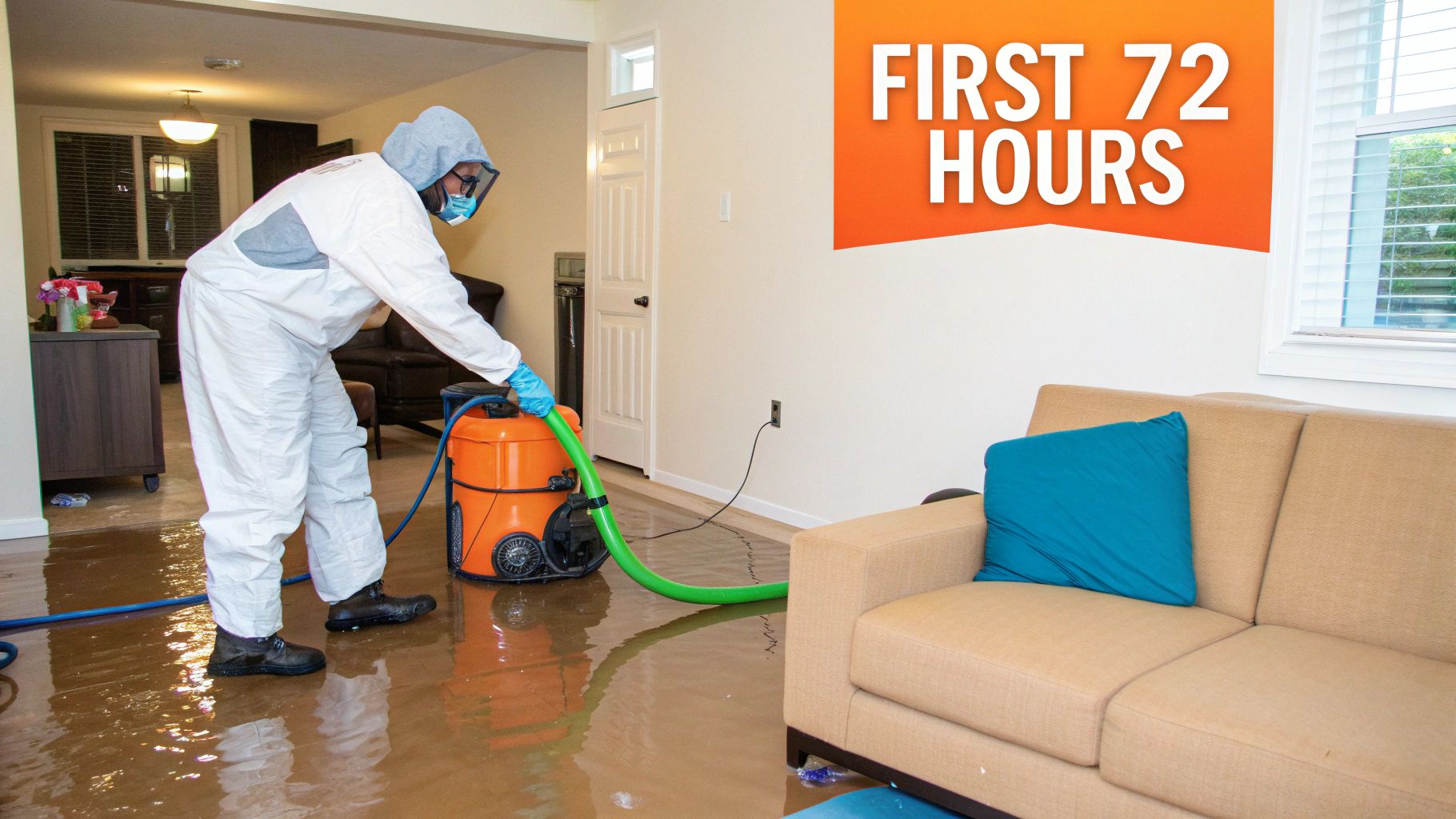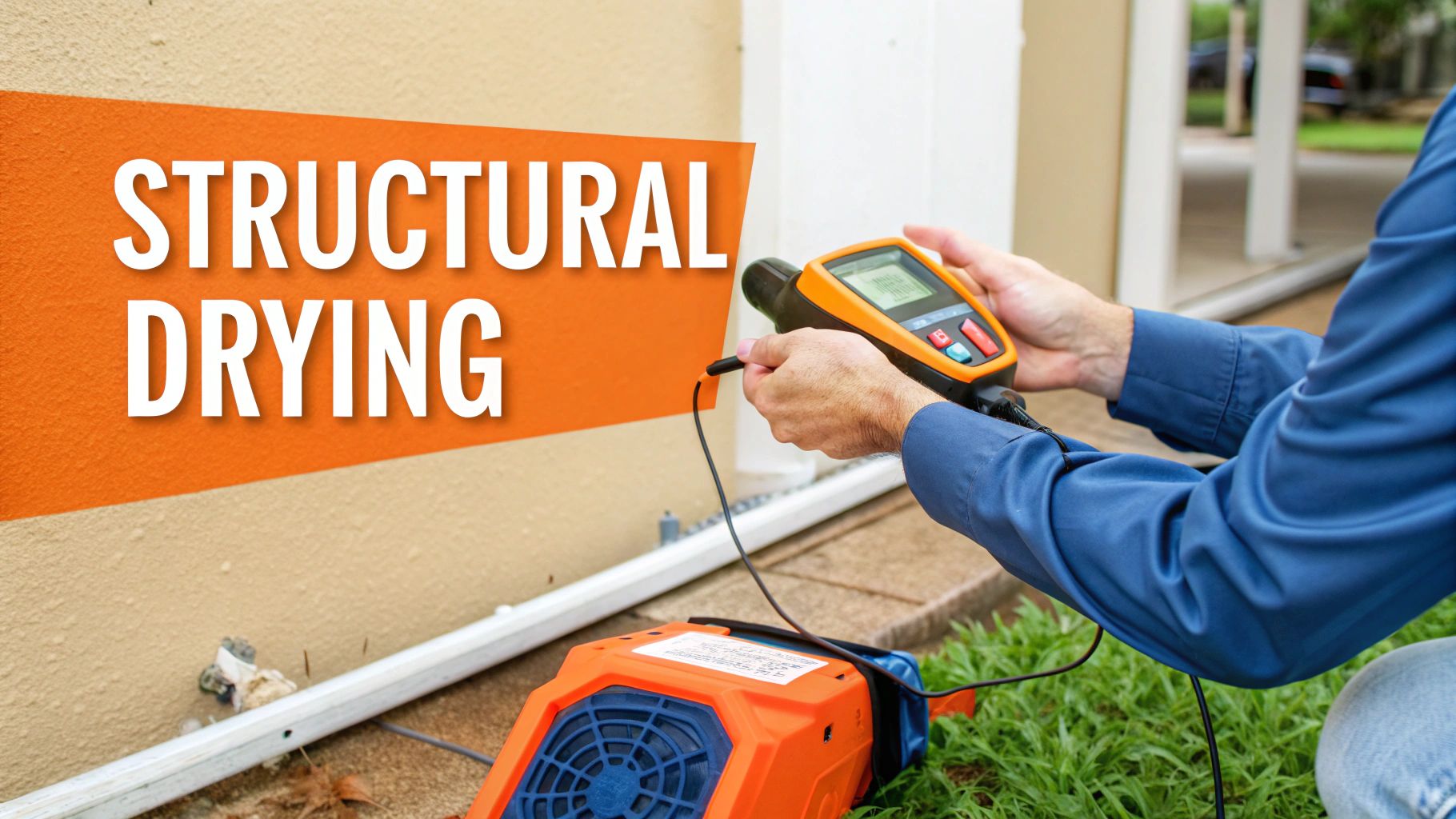When your Orange County home is impacted by a leak or flood, the first question on your mind is almost always, "How long does water damage restoration take?" There's no single answer—the timeline can range from a few days for a minor, contained leak to several weeks or even months for widespread, severe damage.
The total duration ultimately depends on the scope of the problem, the materials affected, and how quickly a professional response begins. As an IICRC Master Certified firm and licensed General Contractor, Sparkle Restoration Services is dedicated to navigating this process with the precision and care your property deserves.
Demystifying Your Restoration Journey
Dealing with water damage is incredibly stressful, but understanding the steps involved can provide a sense of control. This isn't one overwhelming task; it's a structured process that IICRC-certified professionals are trained to manage with expertise.
Think of it as a three-phase process: the emergency response, the scientific drying process, and the final rebuilding phase. Each stage has its own timeline and critical tasks that must be executed flawlessly to protect your home and investment.
As this timeline illustrates, the initial mitigation and drying happen relatively quickly. The rebuilding stage, however, can vary significantly depending on the complexity of the repairs required.
To provide a clearer picture of what to expect, let's break down some typical timelines based on the severity of the damage.
Estimated Water Damage Restoration Timelines
Here is a general overview of how long the different phases might take based on an initial damage assessment. Please remember, these are estimates—every situation is unique and requires a professional evaluation.
| Damage Severity | Drying & Mitigation Phase | Repair & Rebuild Phase | Total Estimated Time |
|---|---|---|---|
| Minor Damage | 2 to 3 days | 1 to 2 days | 3 to 5 days |
| Moderate Damage | 4 to 7 days | 1 to 2 weeks | 1.5 to 3 weeks |
| Severe Damage | 1 to 2 weeks | 2 to 4+ weeks | 3 to 6+ weeks |
These timeframes are a reliable starting point, but the actual duration will depend on several key factors we'll explore next. For a deeper dive into the initial steps, read our guide on what causes water damage. Understanding these variables is the first step in turning chaos into calm, fast.
The Critical First 72 Hours of Restoration
When your Orange County property suffers water damage, the clock starts ticking immediately.
The actions taken within the first 24 to 72 hours are the single most important factor in determining the outcome of the entire water damage restoration project. This initial window is where our IICRC-certified expertise can transform a potential disaster into a managed, efficient process, directly minimizing the final timeline and cost.
From the moment you call Sparkle Restoration Services, our 24/7 emergency response team mobilizes. We arrive with a strategic plan to stop the damage in its tracks and prevent secondary problems like structural decay and mold growth from taking hold.

Immediate Mitigation Actions
Our first priority is to stabilize the environment and remove the bulk water. This rapid mitigation is non-negotiable for protecting your property and preserving its value.
Here’s a look at what our emergency response involves:
- Initial Inspection and Safety Assessment: We first ensure the site is safe, addressing any electrical hazards and identifying the water source. We then assess the scope of the damage to create a precise action plan.
- Immediate Water Extraction: We deploy powerful, truck-mounted extraction equipment to remove all standing water from every affected area. This is a crucial step to prevent porous materials like drywall, wood flooring, and cabinetry from absorbing more water.
- Strategic Equipment Placement: Once standing water is gone, we strategically place industrial-grade air movers and dehumidifiers. This is a calculated setup based on the science of psychrometry, designed to create optimal airflow and initiate the evaporation process.
"The first 72 hours set the stage for the entire project. Rapid water removal and the immediate start of the drying process not only prevent mold but also significantly reduce the scope of necessary repairs, shortening the overall restoration timeline."
Why Speed Is Everything
Delaying professional intervention can dramatically extend your project's timeline and budget. An immediate response within the first 24 hours is the key to controlling the outcome.
Waiting just 48 hours allows mold spores to germinate. A delay of 3 to 7 days can lead to serious structural issues, potentially doubling or even tripling the final restoration costs and timeline.
While our team handles the heavy lifting, knowing what to do in those first moments can be empowering. Having a basic plan can help you stay calm and protect your property until our team arrives. For guidance, review our article on creating a water emergency first aid kit.
Understanding the Science of Structural Drying
Once the standing water is gone, the scientific phase of restoration begins. The drying phase is far more than setting up fans; it’s a precise process managed by IICRC-certified technicians to prevent long-term damage. This stage is absolutely critical, as incomplete drying invariably leads to more significant and costly problems, including mold growth.
We utilize the science of psychrometry—the study of how air, temperature, and moisture interact—to manipulate your home's environment. We don’t just dry the air; we create the ideal conditions that encourage moisture to release itself from deep within materials like drywall, wood studs, and subflooring. This scientific approach is what separates a professional, lasting result from a superficial one.

Accelerating Drying with Specialized Equipment
To achieve this, we deploy a carefully calibrated combination of industrial-grade equipment designed to work in synergy. Each piece of equipment has a specific role in returning your saturated property to a dry, stable, and healthy environment.
- High-Velocity Air Movers: These powerful units are strategically placed to create a vortex of airflow across wet surfaces. This constant motion disrupts the boundary layer of moist, stagnant air, which dramatically accelerates evaporation.
- Low-Grain Refrigerant (LGR) Dehumidifiers: These are the workhorses of the drying process. They draw in humid air, cool it to condense the water vapor, and then exhaust warm, exceptionally dry air back into the space. This process significantly lowers humidity, allowing building materials to release trapped moisture more rapidly.
If this process is delayed or performed incorrectly, moisture becomes trapped within the structure, creating a perfect breeding ground for mold. You can learn more about these risks and our professional solutions in our guide on comprehensive mold remediation services.
Daily Monitoring for Precision and Peace of Mind
Drying is not a "set it and forget it" process. Our technicians return daily to monitor progress and make precise adjustments to the equipment. We use advanced diagnostic tools to ensure every affected material returns to its pre-loss moisture content, known in the industry as its dry standard.
We utilize tools like non-invasive moisture meters and thermal imaging cameras to "see" moisture hidden behind walls and under floors. This data-driven approach allows us to confirm that your home’s structure is completely dry, eliminating guesswork and ensuring the job is done right the first time.
For a deeper technical understanding, it’s worth researching the effective methods for structural drying after a leak to see how professionals guarantee a home is truly dry. This meticulous daily monitoring is how we protect the integrity of your property and provide the peace of mind that comes from proven expertise.
Key Factors That Influence Your Timeline
When facing water damage, homeowners rightfully ask, "How long will this take?" The honest answer is: it depends. No two water damage situations are identical, which is why a one-size-fits-all timeline is not realistic.
Several critical variables shape the project's scope and, ultimately, how long your water damage restoration will take. Understanding these factors from the outset helps set clear expectations and highlights the importance of a professional assessment.
An IICRC-certified technician from Sparkle Restoration Services doesn't guess. We methodically classify the damage using industry-standard metrics. This approach allows us to build a precise, data-driven plan tailored to return your property to pre-loss condition safely and efficiently.
The Category of Water
Not all water is the same. The water's source reveals its contamination level, which directly impacts the entire restoration process—from safety protocols to the final timeline.
For example, damage from Category 1 clean water can often be dried in as little as 2 to 3 days. However, a project involving Category 3 black water requires extensive decontamination and can easily extend over several weeks or even months.
Here is how we classify the water involved:
- Category 1 (Clean Water): Originates from a sanitary source, such as a burst supply line or an overflowing sink. While not immediately harmful, it can degrade to Category 2 if left to sit and absorb bacteria from building materials.
- Category 2 (Gray Water): This water is already contaminated to some degree. Sources include overflows from a washing machine or a dishwasher. It contains detergents and bacteria that can cause illness if ingested.
- Category 3 (Black Water): This is the most serious classification. It is grossly contaminated water from sources like sewage backflow or river flooding, containing dangerous pathogens that require specialized handling, safety gear, and disposal methods.
To provide a clearer picture, this table shows how these categories directly influence a project's timeline and complexity.
How Water Category Affects Restoration Time
The type of water involved is the single biggest factor in determining our approach and schedule. Clean water is a straightforward drying project, but gray and black water introduce significant health risks that necessitate a more cautious and thorough process.
| Water Category | Common Sources | Health Risk | Typical Restoration Complexity & Timeline Impact |
|---|---|---|---|
| Category 1: Clean Water | Burst water supply lines, overflowing sinks or tubs (no soap), appliance malfunctions. | Low | Minimal Complexity. The focus is on extraction and drying. Porous materials like carpet can often be saved. Typically adds 1-2 days to the timeline. |
| Category 2: Gray Water | Washing machine or dishwasher overflows, toilet overflows (urine only), sump pump failures. | Medium | Moderate Complexity. Requires controlled cleaning and disinfection. Some porous materials may need to be removed. Can add 3-5 days to the process. |
| Category 3: Black Water | Sewage backups, toilet overflows (with feces), flooding from rivers or streams, stagnant water. | High | High Complexity. Requires extensive decontamination and disposal of all affected porous materials (drywall, carpet, insulation). Adds 1 week or more due to safety protocols and required testing. |
As you can see, the jump from Category 1 to Category 3 represents a massive leap in the work required, which is why a professional assessment is non-negotiable.
The Class of Damage
Once we identify the type of water, we then determine its "Class," our industry's metric for measuring how much moisture has been absorbed by the building materials. This tells us how saturated the structure is and dictates the necessary drying strategy.
The Class of damage ranges from Class 1 (minor, affecting only low-porosity materials like concrete) to Class 4 (deep saturation requiring specialty drying techniques). The higher the class, the longer and more complex the drying phase.
For example, a small leak on a tile floor is a Class 1 situation—relatively easy to manage. But a burst pipe that has saturated drywall, insulation, and the wood framing behind it is a Class 3 or Class 4 disaster.
Our meticulous approach to classifying both water category and damage class was critical in a recent water damage mitigation and restoration project in Irvine, CA. A precise initial assessment is the foundation for a successful, efficient, and safe restoration.
Navigating the Repair and Rebuilding Phase
Once the emergency has been mitigated and every surface is professionally dried and sanitized, we begin the process of putting your home back together. This is the repair and rebuilding stage, where the timeline can vary the most. The scope of work is dictated entirely by the extent of the damage the water left behind.
This is where our team transitions from mitigation experts to licensed General Contractors, dedicated to restoring your property's function, safety, and beauty. We focus on quality craftsmanship to create a smooth transition from chaos back to comfort, returning your space to its pre-loss condition—or even better.

From Simple Repairs to Complex Rebuilds
The scope of work in this phase can range from minor cosmetic touch-ups to full-scale structural reconstruction. Each of these tasks carries its own timeline, making this part of the job highly variable.
Here are a few examples to illustrate the potential range:
- Minor Repairs (1-7 Days): These are quicker tasks, such as replacing small sections of drywall, installing new baseboards, repainting a water-stained wall, or replacing carpet padding.
- Moderate Repairs (1-4 Weeks): This involves more substantial work, like replacing an entire hardwood floor, rebuilding water-damaged kitchen cabinets, or reinstalling bathroom fixtures.
- Major Rebuilding (4+ Weeks): When damage is severe, the work becomes extensive. This could involve structural framing repairs, replacing subfloors, or a complete remodel of a heavily impacted room.
While initial drying may take 7 to 14 days, the rebuilding phase can extend much longer. A simple paint job may only take a few days, whereas installing custom flooring could take up to four months, and significant structural work can easily range from four to twelve months. This explains why timelines differ so dramatically between projects.
An Opportunity for Upgrades
While restoring your property is the primary goal, this phase presents a unique opportunity. Many Orange County homeowners choose to use the rebuilding process to make desired upgrades, turning a challenging situation into a valuable home improvement project.
As a full-service, award-winning design-build firm, we can help you explore options beyond a simple repair. This could be the perfect time to install the high-end flooring you've been considering or to redesign a bathroom layout for a more modern, functional feel.
Navigating insurance paperwork is a critical part of this process. For expert guidance, please see our guide on navigating property insurance claims for homeowners. As we near completion, understanding what a punch list is in construction is key to ensuring every detail meets your expectations.
We Get These Questions All The Time
Even after we have walked a homeowner through the restoration plan, it is completely normal to have more questions—especially about how the process applies to your home. Here are some of the most common concerns we hear from families in Orange County, along with direct answers based on our extensive experience.
Can I Stay in My Home During the Restoration?
This decision is based on safety and practicality. For a small, contained leak in a single room, you can typically remain in your home.
However, for larger projects, especially those involving contaminated water (Category 2 or 3) or significant structural repairs, it is often unsafe to stay. The noise from industrial fans and dehumidifiers can be disruptive, and there may be concerns about airborne particulates. We will always provide a clear, honest recommendation during our initial inspection, as your family's health and safety are our top priorities.
How Does the Insurance Process Affect the Timeline?
Your insurance claim can certainly influence how long water damage restoration will take. Delays can occur while waiting for an adjuster's approval or for the release of funds.
To mitigate this, our team at Sparkle Restoration Services engages directly with your insurance provider from the start. We submit detailed documentation, moisture logs, and professional assessments to streamline approvals and prevent project stalls. Proactive, transparent communication is essential.
What Can I Do to Help Speed Things Up?
While our IICRC-certified technicians manage the technical work, your partnership is crucial and can significantly impact the timeline. You can help by:
- Providing our 24/7 emergency crews immediate access to the property.
- Making timely decisions on replacement materials like flooring, paint, or cabinets.
- Maintaining open lines of communication for any necessary input or approvals.
Will My Property Ever Be the Same Again?
We understand this question comes from a place of genuine concern. The goal of professional restoration is not just to repair damage—it is to return your home to its pre-loss condition, and in many cases, even better than before.
As a licensed General Contractor and a BBB Torch Award Winner for Ethics, we oversee every detail, from the initial drying to the final coat of paint. Our commitment is to restore not just the structure and aesthetics of your property, but also your sense of security and peace of mind.
When you're dealing with water damage, you need more than just a contractor; you need a trusted partner committed to restoring your life to normal. Sparkle Restoration Services brings IICRC Master Certification and award-winning excellence to every project in Orange County.
If you need immediate 24/7 emergency services or wish to discuss a project, contact us for a consultation.

